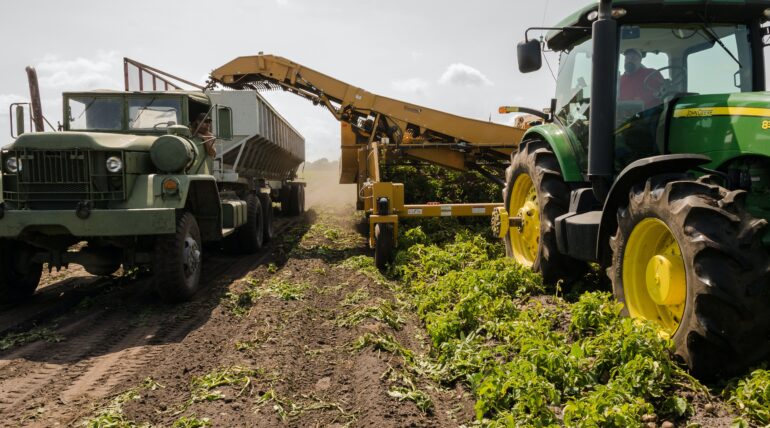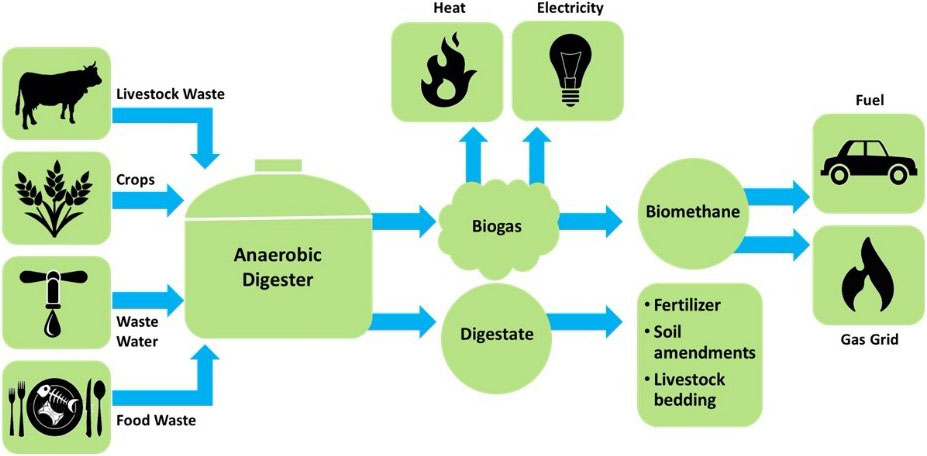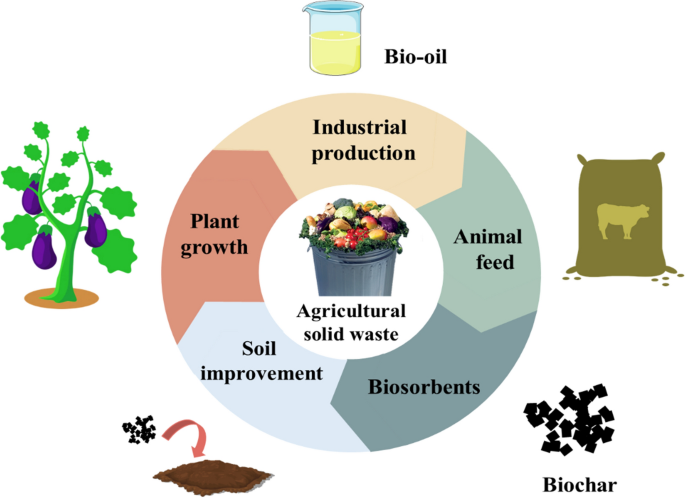

Worldwide, the agricultural sector is indispensable, supplying food and raw materials, and significantly bolstering local and global economies. However, as the global population expands and our dependency on farming and food production increases, the massive scale of agriculture also results in a significant predicament: farm waste.
According to an FAO report, every year, 1.6 billion tons of waste are generated globally, with a significant percentage of this stemming from agricultural practices. This resulting mismanagement of farm waste has proven to be a major contributor to land, water, and air pollution, which also impacts human health and contributes to climate change.
While combating this waste problem is indeed a mammoth challenge, it is not impossible. We will cover all this and more below.
Farm waste, or agricultural waste, refers to the byproducts generated through various farming activities. This waste isn’t merely limited to the farms; it is generated at every step of the food chain, including food and meat processing, horticulture, animal and crop production, on-farm medical procedures, and the use of chemicals.
The waste can take many forms, such as solid waste (bones, peels, feathers), liquid waste (wastewater), chemical waste (pesticides, insecticides), and industrial waste (wood cuttings, paper waste). When left unmanaged, these waste materials can lead to environmental pollution, threatening soil quality, water sources, and air quality.
Farm waste is diverse and can be grouped into several categories, based on the nature of the waste and its potential environmental impact. However, the majority can be broadly classified into 3 major groups:
Dairy farm waste refers to the byproducts and emissions generated from dairy processing activities, such as the production of milk, cheese, butter, milk powder, and other similar products. The byproducts resulting from dairy waste management generally fall into three principal categories: solid waste, wastewater, and air pollution.
The primary source of solid waste from dairy operations is the sludge generated during the wastewater purification process. This sludge is a semi-solid slurry that needs to be properly managed to avoid environmental damage.
The majority of dairy waste, however, is wastewater, which can originate from various stages of dairy processing. This includes cleaning of tanks and pipelines, production processes of different dairy products, and sanitization procedures. This wastewater contains milk solids, detergents, sanitizers, curd particles, and sometimes even residues of spoiled milk.
Air pollution from dairy processing mainly arises from high energy consumption during processes like evaporation, leading to the emission of greenhouse gases like carbon dioxide.
Animal and poultry farm waste primarily refers to manure and urine produced by livestock and poultry animals, including cattle, sheep, and pigs. In addition to excrement, this type of waste also includes bedding materials and leftover feed. However, the specific composition of animal waste can vary based on several factors, including the type of animal, its diet, the bedding material used, and the management practices of the farm.
General farm waste includes an array of organic and non-organic waste materials that are generated during agricultural activities, such as:
Crop residues include parts of plants left in the field after harvest, such as stalks, leaves, and roots. They also include secondary crops like straw or husks. While these materials can be used for composting or soil conditioning, large amounts of crop residues can become a waste management challenge.
Food waste in agriculture comes from several sources. It includes damaged or spoiled crops that are unfit for sale or consumption, leftovers from on-site farm processing, or waste from on-farm animal feeding operations.
Plastic waste on farms includes items like silage wrap, feed bags, plastic containers, and greenhouse covers. These materials can accumulate quickly on a farm, and improper disposal can lead to long-lasting environmental damage.
Pesticides and chemicals are necessary for maintaining healthy crops, but they can also contribute to the overall waste problem. This includes leftover or expired chemicals, as well as containers or equipment used for their storage and application.

The issue of farm waste has been gaining considerable attention due to its potential environmental impact, and the following numbers underscore the gravity of the situation.
With the potential risks and environmental damage caused by agricultural waste, there is a critical need for effective waste management practices. From harmful greenhouse gas emissions to water pollution and even land and waterway blockages, the consequences of unmanaged farm waste are dire.
The excessive or improper use of manure and chemical fertilizers can lead to the accumulation of heavy metals in the soil, such as lead, mercury, and cadmium. Over time, these substances can degrade soil quality and disrupt the balance of soil microorganisms, affecting plant growth and the health of the broader ecosystem. Furthermore, persistent organic pollutants, including pesticide residues, can accumulate in the soil, posing risks to the environment and potentially entering the food chain.
It can also lead to serious water pollution issues. Nutrients from manure and chemical fertilizers, such as nitrogen and phosphorus, can leach into groundwater or run off into rivers and lakes. This can lead to eutrophication, a process where an excess of nutrients in water bodies causes algal blooms, depletes oxygen levels, and harms aquatic life. Moreover, chemicals and antibiotics used in farming can contaminate water bodies, posing risks to both human health and biodiversity.
The decomposition of organic farm waste produces gases like methane and nitrous oxide, which are potent greenhouse gases. Additionally, the burning of agricultural residues can release particulate matter and harmful gases into the atmosphere, affecting air quality and human health.
Agricultural waste can harm biodiversity both directly and indirectly.
Failure to properly dispose of farm waste can result in legal consequences. Numerous laws and regulations govern these practices to protect public health and the environment. In the United States, for example, the Environmental Protection Agency (EPA) oversees regulations related to agricultural waste under several federal laws, including the Clean Water Act and the Resource Conservation and Recovery Act.
Therefore, understanding and adhering to appropriate waste management practices is not only crucial for the environment and public health but also for the legal and reputational standing of farming operations.
If processed correctly, there are several innovative agricultural waste solutions where farm waste can transition from a liability to a valuable resource. There are several uses to agricultural waste:

Anaerobic digestion is a process where microorganisms break down organic materials, such as livestock manure and crop residues, in the absence of oxygen. This process of producing biogas, a mixture of methane and carbon dioxide, which can be used for heat and power generation. It also produces nutrient-rich digestate, a by-product that can be used as a high-quality fertilizer.
This age-old technique remains one of the most effective methods of turning organic farm waste into a valuable resource. Composting and animal waste management transforms plant and animal wastes into rich, fertile compost that can enhance soil health and fertility. Modern composting systems can handle large volumes of waste and are often more efficient than traditional methods.
Advanced technologies now exist that can process various types of farm waste – including livestock manure, crop residues, and food waste – into organic and inorganic fertilizers. These technologies can improve nutrient recovery, reduce greenhouse gas emissions, and produce high-quality fertilizers that can meet specific crop nutrient requirements. Farmers can also benefit from converting food waste to animal feed.
Biochar is a type of charcoal that is produced by pyrolysis of organic waste. It can improve soil health, increase crop yields, and sequester carbon. It can also be used as a feed additive to reduce methane emissions from livestock.
Innovations in bioengineering and biotechnology are opening opportunities to convert farm waste into biomaterials, such as bioplastics, biofabrics and biofuels. This not only provides an additional income stream for farmers but also contributes to a circular economy and reduces dependence on fossil fuels.
To fully achieve this transformation, farmers and businesses need support from experts in waste management. Establishing an effective and successful farm waste management plan that works and cuts on cost is no easy feat. Companies like Shapiro provide comprehensive waste recycling, disposal and biochar services that can help you navigate the intricacies of agricultural waste and disposal solutions. This will ensure compliance with regulations while maximizing the potential of your waste.
Farm waste becomes a problem when it’s improperly managed and disposed of. It leads to pollution, health hazards, and inefficient use of potential resources.
Farm waste, when not correctly managed, can contribute to water and soil pollution through nutrient run-off, increase greenhouse gas emissions, and negatively impact biodiversity.
Farm waste can be transformed into a resource through various methods. These include composting to enrich soils, anaerobic digestion to produce biogas for energy, and conversion into biofertilizers or feed for livestock.
Farmers can reduce waste by implementing more efficient farming practices, optimizing feed rationing for livestock, composting organic waste, or recycling farm waste into bioenergy or fertilizer.
Baily Ramsey, an accomplished marketing specialist, brings a unique blend of anthropological insight and marketing finesse to the digital landscape. Specializing in educational content creation, she creates content for various industries, with a particular interest in environmental initiatives.